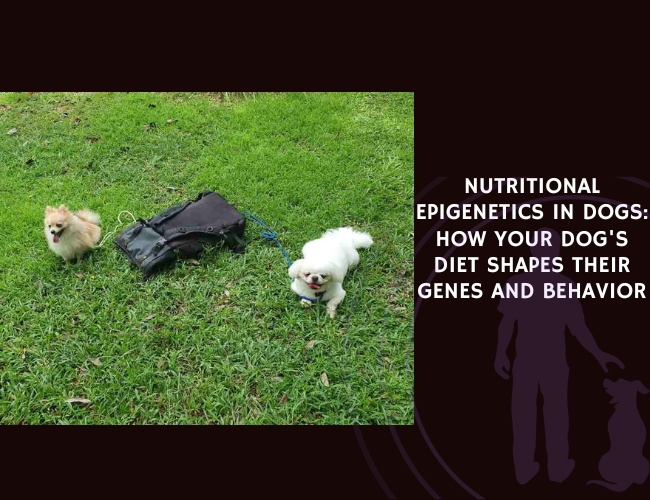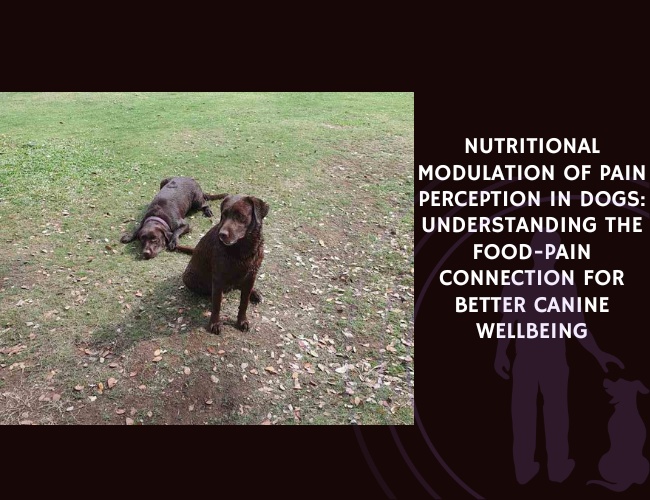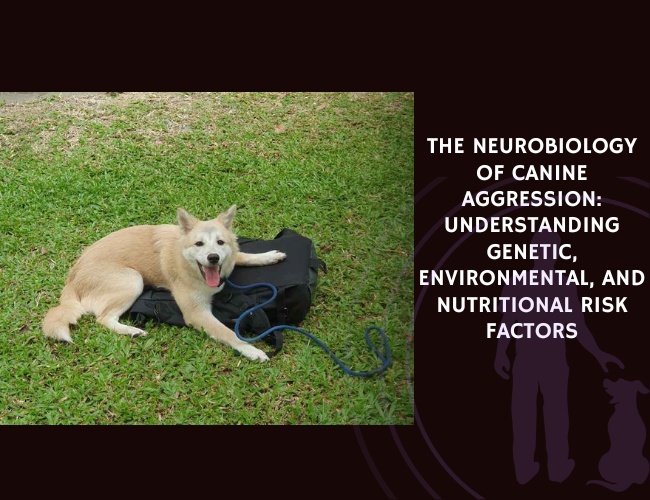Introduction: The Revolutionary Science Behind Your Dog’s Bowl
Did you know that every meal you serve your furry friend is quite literally rewriting their genetic story? Welcome to the fascinating world of nutritional epigenetics—where the simple act of filling your dog’s bowl becomes a powerful tool for shaping their health, behavior, and even the wellbeing of future generations. This isn’t just about calories and nutrients anymore; it’s about how food talks directly to your dog’s genes, turning them on and off like switches in ways that can profoundly impact everything from their anxiety levels to their disease resistance.
For decades, we’ve understood that good nutrition keeps our dogs healthy. But now, groundbreaking research reveals something far more remarkable: the food your dog eats doesn’t just fuel their body—it actively modifies how their genes express themselves. This means that the right dietary choices can help your anxious rescue become calmer, your aging companion stay sharper, and even influence the health of puppies not yet born. Let us guide you through this revolutionary understanding of canine nutrition, where every ingredient becomes a potential key to unlocking your dog’s best genetic potential.
Understanding Epigenetics: Your Dog’s Genetic Control Panel
What Epigenetics Means for Your Canine Companion
Think of your dog’s DNA as a massive library of instruction manuals—every gene is a book containing specific directions for building and maintaining their body. But here’s the fascinating part: not all these books need to be read at once. Epigenetics acts like a librarian, deciding which books to pull off the shelf and which to keep closed. This process doesn’t change the words in the books (the DNA sequence stays the same), but it dramatically changes which instructions your dog’s body follows.
When we talk about epigenetic mechanisms in dogs, we’re referring to three main processes that control gene expression. DNA methylation is like putting sticky notes on certain genes that say “skip this one”—it typically silences genes by adding methyl groups to the DNA. Histone modifications work by changing how tightly DNA is wrapped around protein spools called histones—imagine trying to read a scroll that’s wound too tight versus one that’s loosely rolled. Finally, non-coding RNAs act as messengers that can intercept and modify genetic instructions before they’re carried out.
What makes this especially exciting for dog owners is that unlike genetic mutations, which are permanent, epigenetic changes are potentially reversible. This means that through thoughtful dietary interventions, you might be able to “reprogram” certain aspects of your dog’s genetic expression, potentially improving their behavior, health, and quality of life. 🧡
The Diet-Gene Connection
Every time your dog takes a bite of food, they’re consuming more than just calories—they’re taking in molecular tools that can modify their epigenome. Specific nutrients act as raw materials for the enzymes that add or remove epigenetic marks. It’s like providing your dog’s cells with an editing toolkit for their genetic manuscript. Some nutrients add punctuation marks that emphasize certain genes, while others act like erasers, removing marks that have been silencing important genetic instructions.
This connection between diet and genes helps explain why two dogs with identical genetics—like littermates—can develop such different health outcomes and personalities based on their nutrition and environment. It’s not just nature or nurture; it’s nature being nurtured through nutrition in ways we’re only beginning to understand.
Key Nutrients That Rewrite Your Dog’s Genetic Code
The Methyl Donor Powerhouse Team
At the heart of nutritional epigenetics are the methyl donors—a group of nutrients that work together like a well-coordinated construction crew, adding methyl groups to your dog’s DNA where needed. The star players in this team include folate, vitamin B12, choline, and methionine. These nutrients don’t work in isolation; they’re part of an intricate metabolic dance called the one-carbon metabolism cycle.
When your dog’s diet lacks these crucial methyl donors, it’s like trying to build a house without enough nails—the structure becomes unstable. Research has shown that insufficient methyl donors can lead to abnormal gene expression patterns associated with inflammatory conditions, autoimmune responses, and even behavioral changes. For instance, a diet deficient in folate might result in inadequate methylation of genes responsible for neurotransmitter production, potentially contributing to anxiety or cognitive issues in your dog.
The practical implications are profound. A pregnant dog receiving optimal levels of these nutrients isn’t just nourishing her puppies—she’s establishing healthy methylation patterns that will influence their stress responses, immune function, and metabolic health throughout their lives. This is why quality commercial dog foods now pay careful attention to B-vitamin fortification, and why veterinary nutritionists might recommend specific supplements for breeding dogs or those with certain health conditions.
Histone Modifiers: The Chromatin Architects
While methyl donors grab much of the spotlight, nutrients that influence histone modifications are equally important in your dog’s epigenetic symphony. These modifications determine how accessible genes are for reading—imagine the difference between a book locked in a safe versus one lying open on a table. Certain dietary components provide acetyl groups that, when attached to histones, loosen the DNA packaging and make genes more accessible for expression.
Short-chain fatty acids (SCFAs), produced when your dog’s gut bacteria ferment dietary fiber, are particularly powerful histone modifiers. When your dog eats foods rich in prebiotics—like sweet potatoes, pumpkin, or chicory root—their gut microbiome produces SCFAs like butyrate and propionate. These compounds don’t just support digestive health; they travel throughout the body, influencing gene expression in the brain, immune system, and other organs. This connection helps explain why dogs fed high-fiber diets often show improvements in both digestive issues and seemingly unrelated problems like anxiety or skin conditions.
The protein quality in your dog’s diet also matters here. Amino acids from high-quality proteins provide the building blocks for enzymes called histone acetyltransferases and histone deacetylases—the molecular machines that add or remove acetyl groups from histones. This is why feeding your dog complete proteins from quality sources isn’t just about muscle maintenance; it’s about providing the tools for proper genetic regulation.
Omega-3s, Polyphenols, and Antioxidants: The Protective Brigade
Beyond the basic methyl donors and histone modifiers lies a fascinating group of bioactive compounds that act like genetic guardians. Omega-3 fatty acids, particularly EPA and DHA found in fish oil, don’t just reduce inflammation—they actively modify the expression of genes involved in inflammatory responses, potentially dial down your dog’s predisposition to allergies, arthritis, and even certain cancers.
Polyphenols, those colorful compounds found in blueberries, green tea, and certain vegetables safe for dogs, work as epigenetic modulators in multiple ways. They can influence DNA methylation patterns, modify histone acetylation, and regulate microRNAs—tiny RNA molecules that fine-tune gene expression. When you add a handful of blueberries to your dog’s breakfast, you’re not just providing antioxidants; you’re delivering compounds that can help silence genes associated with tumor growth while activating those involved in cellular repair and longevity.
The antioxidant network—including vitamins E and C, selenium, and carotenoids—provides another layer of epigenetic protection. These nutrients help prevent oxidative damage to the enzymes responsible for maintaining proper DNA methylation patterns. Think of them as the maintenance crew that keeps your dog’s epigenetic machinery running smoothly, preventing the accumulation of errors that could lead to disease or premature aging. 🐾
How Diet Shapes Your Dog’s Behavior Through Epigenetics
The Anxiety-Aggression-Diet Triangle
Have you ever wondered why some dogs seem naturally calm while others are perpetually on edge? While genetics and training certainly play roles, emerging research suggests that diet-driven epigenetic changes significantly influence canine behavior, particularly regarding anxiety and aggression. The food your dog eats can literally change how their brain processes stress and social information.
When dogs consume diets high in processed ingredients and low in essential nutrients, it can lead to pro-inflammatory states that affect gene expression in the brain. Research in animal models has shown that Western-style diets—high in processed fats and sugars—can epigenetically modify genes involved in the stress response system, making individuals more anxious and less socially integrated. These dietary patterns alter the expression of genes controlling inflammation in the brain, particularly in regions like the amygdala and hippocampus that govern fear responses and emotional regulation.
Conversely, diets rich in omega-3 fatty acids, B-vitamins, and antioxidants support healthy methylation patterns in genes related to emotional stability. Dogs fed these nutrient-dense diets often show improved stress resilience, better impulse control, and more appropriate social behaviors. This isn’t just about feeling good—it’s about epigenetic modifications that enhance the brain’s ability to produce and regulate calming neurotransmitters while dampening overactive stress responses.
Neurotransmitter Regulation Through Nutritional Epigenetics
The connection between your dog’s gut and brain goes far deeper than we once imagined. Short-chain fatty acids produced by gut bacteria from dietary fiber can epigenetically influence the expression of genes involved in neurotransmitter production. For example, the SCFA propionate has been shown to affect the tyrosine hydroxylase gene, which controls the production of dopamine—a neurotransmitter crucial for motivation, reward processing, and movement control.
This means that a diet supporting healthy gut fermentation doesn’t just improve digestion; it can enhance your dog’s mood, motivation, and cognitive flexibility. Dogs with optimal gut health often display better problem-solving abilities, increased trainability, and more stable moods. The dietary fiber acts as a prebiotic, feeding beneficial bacteria that produce these neuroactive compounds, which then travel to the brain and modify gene expression in ways that support mental health.
Tryptophan, an amino acid found in turkey, eggs, and certain fish, provides another fascinating example. Beyond being a precursor to serotonin (the “happiness” neurotransmitter), adequate tryptophan levels support proper methylation of genes involved in the serotonin system. This dual action—providing both the raw material for neurotransmitter synthesis and the epigenetic support for expressing the genes that use it—illustrates why protein quality matters so much for behavioral health.

Stress Response and Resilience Building
Your dog’s ability to bounce back from stressful situations isn’t just about training—it’s encoded in their epigenetic stress response system, which diet can significantly influence. The hypothalamic-pituitary-adrenal (HPA) axis, your dog’s primary stress response system, is particularly sensitive to nutritional epigenetic programming.
Dogs receiving adequate magnesium, zinc, and B-vitamins show healthier methylation patterns in genes regulating cortisol production and sensitivity. This means they can mount an appropriate stress response when needed but also efficiently return to baseline once the threat passes. In contrast, nutritional deficiencies can lead to hypomethylation of glucocorticoid receptor genes, resulting in dogs that either over-respond to minor stressors or fail to respond appropriately to genuine threats.
The timing of nutritional interventions matters enormously. Puppies experiencing optimal nutrition during critical developmental windows develop more robust stress resilience that persists throughout their lives. However, even adult dogs can benefit from dietary improvements, as many stress-related epigenetic marks remain modifiable throughout life. This plasticity offers hope for rescue dogs or those with anxiety disorders—with patience and proper nutrition, their stress response systems can be gradually reprogrammed toward greater resilience.
Maternal Nutrition: Programming the Next Generation
The Power of Prenatal Nutrition
When a pregnant dog eats, she’s not just nourishing her developing puppies—she’s literally programming their genetic expression patterns for life. This concept, known as “developmental programming” or the “fetal origins of adult disease,” reveals that maternal nutrition during pregnancy creates epigenetic marks that influence everything from the puppies’ future disease risk to their behavioral tendencies.
During fetal development, the puppies’ cells are rapidly dividing and differentiating, making them exquisitely sensitive to nutritional signals. A mother dog receiving optimal levels of folate, choline, and other methyl donors ensures proper DNA methylation patterns in her puppies’ developing brains. These patterns influence how neurons connect, how neurotransmitter systems develop, and even how the stress response system calibrates itself. Puppies from well-nourished mothers often show better emotional regulation, enhanced learning ability, and stronger immune systems—benefits that persist throughout their lives.
Conversely, maternal nutritional stress or deficiency can lead to problematic epigenetic programming. Research has shown that protein restriction during pregnancy can cause persistent hypomethylation of genes involved in metabolism and stress response, potentially predisposing puppies to obesity, diabetes, and anxiety disorders later in life. This isn’t about blame—it’s about understanding how crucial proper prenatal nutrition is and why breeding dogs deserve especially careful nutritional support.
Critical Windows: From Conception Through Weaning
The journey of nutritional epigenetic programming doesn’t begin at birth—it starts even before conception. The nutritional status of both parents at the time of mating influences the epigenetic marks in their gametes (egg and sperm cells). Fascinating research has shown that paternal diet can affect offspring health through epigenetic modifications in sperm, influencing everything from metabolism to behavior in the puppies.
The period of in utero development represents the most critical window for epigenetic programming. During this time, major organ systems are forming, and epigenetic patterns are being established that will govern gene expression throughout life. The first trimester is particularly crucial for neural development, where maternal nutrition influences the methylation patterns of genes involved in brain structure and function. The second and third trimesters see rapid growth and continued epigenetic fine-tuning, where nutrients like DHA become critical for proper brain and retinal development.
But the window doesn’t close at birth. The lactation period offers another opportunity for nutritional epigenetic influence. Mother’s milk doesn’t just provide calories and antibodies—it delivers epigenetic regulators like microRNAs that can modify gene expression in the nursing puppies. The composition of the milk, influenced by the mother’s diet, can affect the puppies’ gut development, immune system maturation, and even their future food preferences. This is why supporting nursing mothers with high-quality nutrition pays dividends in puppy health and development.
Building Behavioral Resilience from the Start
The behavioral implications of maternal nutrition extend far beyond basic temperament. Puppies from mothers who received diets rich in omega-3 fatty acids during pregnancy often display enhanced cognitive abilities, better impulse control, and increased trainability. These aren’t just correlations—they’re the result of specific epigenetic modifications in genes governing neural plasticity, neurotransmitter function, and stress response.
Particularly interesting is how maternal nutrition influences social behavior development. Adequate levels of certain nutrients during pregnancy support proper methylation of genes involved in oxytocin and vasopressin systems—the neurochemical foundations of social bonding and recognition. Puppies from well-nourished mothers often show stronger attachment behaviors, better social learning, and more appropriate play behaviors. They’re literally programmed for better social success through their mother’s diet.
The stress resilience programmed through maternal nutrition has lifelong implications. Mothers receiving adequate B-vitamins, magnesium, and adaptogenic compounds (from foods like pumpkin seeds or certain safe herbs) during pregnancy produce puppies with more balanced HPA-axis function. These puppies grow into dogs that handle veterinary visits better, adapt more easily to new situations, and show fewer fear-based behavioral problems. It’s nature’s way of preparing the next generation for the challenges they’ll face, guided by the nutritional wisdom we provide. 🧡
Lasting. Adaptive. Generational.
Early life nutrition sets the stage for everything that follows.
From the moment a puppy begins weaning, every nutrient influences how their genes get “tuned.” B-vitamin levels shape emotional regulation, while fatty acids foster cognitive development.
Adult dogs carry the echoes of past meals—and still respond to new ones.
Epigenetics isn’t a fixed script. It’s a score that evolves with life’s orchestra. Adult dogs’ gene expression can still shift based on dietary inputs: inflammation levels can be turned down, brain plasticity enhanced, and immune responses recalibrated.



What your dog eats today can shape the lives of dogs yet unborn.
If your dog is part of a breeding line, nutritional epigenetics doesn’t stop with them. Methylation patterns and gene expressions are passed on to offspring, influencing their health, temperament, and disease risk. It’s not just legacy—it’s biochemical inheritance.
Transgenerational Effects: Your Choices Echo Through Generations
Beyond Parent to Pup: Multi-Generational Impact
Here’s where nutritional epigenetics becomes truly mind-bending: the dietary choices you make for your dog today could influence the health and behavior of their grandpuppies and even great-grandpuppies. This transgenerational inheritance of epigenetic marks means that nutritional decisions echo through generations in ways we’re only beginning to understand.
Unlike genetic mutations, which are random and relatively rare, epigenetic inheritance is responsive to environmental factors like diet. When your dog experiences significant nutritional stress or abundance, some of these epigenetic modifications can be passed through the germline (the cells that become eggs or sperm) to future generations. This means a dog that experiences malnutrition might pass on epigenetic marks that predispose their descendants to metabolic thriftiness—helpful if food scarcity continues, but potentially leading to obesity if food becomes plentiful.
Research in laboratory animals has demonstrated that dietary interventions in one generation can affect anxiety levels, metabolic efficiency, and disease susceptibility three or four generations later. While specific multi-generational studies in dogs are still emerging, the principles appear consistent across mammalian species. This suggests that breeding dogs fed optimal diets aren’t just producing healthier puppies—they’re potentially improving the genetic expression patterns for generations to come.
Behavioral Inheritance Through Nutritional Epigenetics
The inheritance of behavioral traits through nutritional epigenetic mechanisms is particularly fascinating. When a dog experiences chronic stress combined with poor nutrition, it can create epigenetic marks on genes involved in stress response and emotional regulation. Some of these marks can persist through the germline, meaning the puppies might inherit a predisposition toward anxiety or heightened stress sensitivity—even if they themselves never experience nutritional stress.
Conversely, dogs maintained on diets rich in stress-buffering nutrients (like magnesium, B-vitamins, and omega-3s) may pass on epigenetic patterns that promote emotional resilience in their offspring. This isn’t deterministic—environment and training still matter enormously—but it does suggest that nutritional excellence in breeding dogs is an investment in the behavioral health of future generations.
The implications for breeding programs are profound. Breeders focusing solely on physical traits and genetic health testing might be missing a crucial component: nutritional epigenetic optimization. By ensuring breeding dogs receive exceptional nutrition not just during pregnancy but throughout their lives, we might be able to gradually improve behavioral stability and stress resilience across breed populations.
Breaking Negative Cycles, Building Positive Ones
The good news about nutritional epigenetics is its potential reversibility. Even if a dog comes from generations of nutritionally stressed ancestors, targeted dietary interventions can begin to reverse problematic epigenetic patterns. This offers hope for rescue dogs with unknown backgrounds or breeds with high prevalence of anxiety disorders.
Strategic supplementation with methyl donors, omega-3 fatty acids, and other epigenetic modifiers can gradually shift gene expression patterns toward healthier states. While some developmental windows are critical and time-limited, many epigenetic marks remain plastic throughout life. This means that improving your dog’s diet at any age can have benefits not just for them but potentially for their future offspring.
Creating positive nutritional epigenetic cycles requires consistency and patience. It’s not about perfection but about providing steady, high-quality nutrition that supports healthy gene expression. Over time, these positive patterns can become established and, in breeding dogs, potentially transmitted to future generations. You’re not just feeding your dog—you’re participating in an ongoing biological conversation between nutrition and genetics that shapes the future of canine health.
Raw vs. Processed: The Epigenetic Implications of Food Preparation
How Processing Changes the Epigenetic Potential of Food
The debate between raw and processed dog foods takes on new dimensions when viewed through an epigenetic lens. It’s not just about nutrient content—it’s about how food processing affects the bioavailability and functionality of epigenetic modifiers. When we heat, extrude, or otherwise process dog food, we’re potentially altering its ability to influence gene expression.
Heat processing, common in kibble production, can degrade heat-sensitive B-vitamins crucial for methylation processes. While manufacturers often add these vitamins back, the synthetic forms may not have the same epigenetic activity as their natural counterparts. Additionally, high-temperature processing can create advanced glycation end products (AGEs) and other compounds that promote inflammation and may negatively influence epigenetic patterns related to aging and disease.
Raw diets, conversely, preserve natural enzyme systems and maintain the integrity of bioactive compounds like polyphenols and certain vitamins. The living enzymes in raw food may aid in the production of beneficial metabolites that serve as epigenetic modifiers. However, raw diets also come with risks—bacterial contamination, nutritional imbalances, and the potential for parasites—that could create stress responses affecting epigenetic patterns negatively.

Bioavailability and Epigenetic Accessibility
The form in which nutrients are delivered matters enormously for their epigenetic effects. Whole food sources provide nutrients in complex matrices with cofactors that enhance absorption and utilization. For instance, the folate in leafy greens comes packaged with other B-vitamins, minerals, and phytonutrients that work synergistically to support methylation processes.
Processed foods often rely on synthetic vitamin premixes to meet nutritional standards. While these ensure minimum requirements are met, they may not provide the full spectrum of compounds needed for optimal epigenetic regulation. The difference is like comparing a solo musician to a full orchestra—both can play the melody, but the richness and complexity differ dramatically.
Fermented foods represent an interesting middle ground. Fermentation can increase the bioavailability of certain nutrients while producing beneficial metabolites like SCFAs that have direct epigenetic effects. Some premium dog foods now incorporate fermented ingredients, attempting to harness these benefits while maintaining food safety and convenience.
Finding the Optimal Balance
The ideal approach to feeding for epigenetic health likely isn’t purely raw or completely processed, but rather a thoughtful combination that maximizes benefits while minimizing risks. This might mean a base of high-quality, minimally processed commercial food supplemented with fresh, whole food toppers rich in epigenetic modifiers.
Consider adding fresh blueberries for polyphenols, lightly steamed broccoli for sulforaphane (a powerful epigenetic modifier), or sardines for omega-3s and naturally occurring vitamin D. These additions provide bioactive compounds in their natural forms while maintaining the convenience and safety of commercial foods. The key is variety and quality—rotating different whole food additions ensures a broad spectrum of epigenetic modifiers while preventing nutrient imbalances.
Ultimately, the best diet for epigenetic health is one that you can consistently provide, that your dog thrives on, and that delivers a diverse array of nutrients in bioavailable forms. Whether that’s raw, cooked, or a combination, the focus should be on nutrient density, ingredient quality, and the inclusion of foods known to support healthy gene expression patterns.
Practical Applications: Optimizing Your Dog’s Epigenetic Health
Building an Epigenetically Supportive Diet
Creating a diet that supports optimal gene expression doesn’t require a degree in molecular biology—it requires understanding a few key principles and applying them consistently. Start with a foundation of high-quality protein from varied sources. Different proteins provide different amino acid profiles, supporting various aspects of epigenetic regulation. Rotate between fish, poultry, and appropriate red meats to ensure comprehensive amino acid coverage.
Next, focus on the “epigenetic superfoods” for dogs. Sardines and salmon provide omega-3s and vitamin D. Eggs offer choline, B-vitamins, and complete proteins. Blueberries and cranberries deliver polyphenols without excessive sugar. Pumpkin and sweet potato provide fiber for SCFA production plus beta-carotene. Leafy greens like spinach (in moderation) supply folate and other methyl donors. Bone broth provides glycine and other amino acids that support methylation processes.
Don’t forget about the importance of fiber diversity. Different fibers feed different beneficial bacteria, which produce various SCFAs and other metabolites with epigenetic effects. Rotating between sources like ground flaxseed, chia seeds, and vegetable fibers ensures your dog’s microbiome produces a full spectrum of beneficial compounds. Remember, you’re not just feeding your dog—you’re feeding the trillions of bacteria that help regulate their gene expression.
Supplementation Strategies for Epigenetic Support
While whole foods should form the foundation, targeted supplementation can provide additional epigenetic support, especially for dogs with specific health challenges or those recovering from nutritional stress. A high-quality methylation support supplement containing folate, B12, B6, and trimethylglycine can help dogs with anxiety, cognitive decline, or chronic inflammation—all conditions linked to methylation imbalances.
Omega-3 supplementation deserves special attention. The EPA and DHA in fish oil don’t just reduce inflammation; they actively modify gene expression in ways that support cognitive function, reduce anxiety, and may even slow aging processes. Aim for a supplement providing about 20-40mg of combined EPA and DHA per pound of body weight daily, though always consult with your veterinarian for specific recommendations.
Probiotic supplementation represents another powerful tool for epigenetic optimization. Different bacterial strains produce different metabolites with varying epigenetic effects. Look for multi-strain probiotics that include Lactobacillus and Bifidobacterium species, which are particularly good at producing beneficial SCFAs. Combined with prebiotic fibers, these supplements can significantly influence gene expression patterns throughout your dog’s body.
Monitoring and Adjusting Your Approach
Optimizing your dog’s epigenetic health is an ongoing process that requires observation and adjustment. Watch for signs that the dietary changes are working: improved coat quality, better energy levels, enhanced mood stability, and stronger stress resilience. These changes might take weeks or even months to become apparent, as epigenetic modifications occur gradually.
Keep a simple journal noting dietary changes and behavioral observations. You might notice that adding certain foods correlates with calmer behavior or better training responsiveness. These observations aren’t just coincidental—they likely reflect real changes in gene expression patterns affecting neurotransmitter production and stress response systems.
Remember that every dog is unique, with their own genetic background, health history, and epigenetic starting point. What works brilliantly for one dog might need modification for another. Be patient, consistent, and willing to adjust your approach based on your dog’s response. The goal isn’t perfection but rather steady progress toward optimal gene expression and health. 🐾
Special Considerations for Different Life Stages
Puppy Development: Setting the Epigenetic Foundation
The puppy stage represents the most critical period for nutritional epigenetic programming outside of prenatal development. During the first year of life, rapidly developing systems are particularly sensitive to nutritional influences that create lasting epigenetic patterns. This is when you’re literally setting the stage for your dog’s lifelong health and behavior patterns.
Puppies need higher levels of certain epigenetic modifiers than adult dogs. Their rapidly growing brains require abundant DHA for proper neural development and methylation of neurodevelopmental genes. Their developing immune systems benefit from diverse polyphenols and antioxidants that help establish balanced inflammatory response patterns. The gut microbiome, which is establishing itself during puppyhood, needs varied fibers to develop the capacity for producing beneficial epigenetic metabolites.
Pay special attention to protein quality during this stage. The amino acids from protein don’t just build muscle—they provide the substrates for the enzymes that write and erase epigenetic marks. Puppies on high-quality, varied protein sources often show better trainability and emotional stability, likely due to optimized neurotransmitter gene expression patterns established during this critical period.
Adult Maintenance: Sustaining Optimal Gene Expression
Adult dogs might seem stable in their development, but their epigenomes remain dynamic and responsive to nutritional influences. This is the stage where consistent, high-quality nutrition can prevent the accumulation of problematic epigenetic changes associated with aging and disease development.
Focus on maintaining methylation capacity as your dog ages. Adult dogs often face increasing oxidative stress, which can disrupt methylation patterns. Ensuring adequate antioxidants alongside methyl donors helps preserve healthy gene expression patterns. This is particularly important for working dogs, athletes, or those facing chronic stress, as these conditions increase the demand for epigenetic support nutrients.
Consider seasonal adjustments to your dog’s epigenetic support. During periods of higher stress (moving homes, adding family members, intensive training), increasing omega-3s and B-vitamins can help maintain stable gene expression patterns in stress response systems. During recovery from illness or injury, additional protein and specific amino acids support the epigenetic changes necessary for tissue repair and immune function restoration.
Senior Support: Reversing Age-Related Epigenetic Changes
As dogs age, they accumulate epigenetic changes that contribute to age-related decline—a process called “epigenetic drift.” However, research suggests that many of these changes are reversible or at least modifiable through targeted nutrition. This offers hope for maintaining cognitive function, mobility, and quality of life in senior dogs.
Senior dogs often benefit from increased levels of specific epigenetic modifiers. SAMe (S-adenosylmethionine), a methyl donor that also supports joint health, can help maintain proper methylation patterns while addressing age-related arthritis. Resveratrol and other polyphenols may help reverse some age-related epigenetic changes, particularly those affecting cellular energy production and inflammation.
The aging gut microbiome also needs special attention. Senior dogs often show reduced microbial diversity, leading to decreased production of beneficial SCFAs and other epigenetic modulators. Increasing prebiotic fibers and considering probiotic supplementation can help maintain the gut-brain axis and support healthy gene expression patterns in the aging brain. This nutritional support might help prevent or slow cognitive dysfunction syndrome—the canine equivalent of dementia.
Conclusion: Your Dog’s Genetic Destiny Is in Your Hands
As we close this exploration of nutritional epigenetics in dogs, it’s important to recognize the profound responsibility and opportunity that comes with this knowledge. Every meal you provide, every treat you offer, and every supplement you consider is participating in an ongoing conversation with your dog’s genes. You’re not just a pet owner—you’re an epigenetic conductor, orchestrating the expression of your dog’s genetic potential through the foods you choose.
The science of nutritional epigenetics transforms how we think about canine nutrition. It’s no longer sufficient to meet minimum nutritional requirements; we now understand that optimal nutrition means providing the full spectrum of compounds that support healthy gene expression. This doesn’t mean perfection is required—rather, it means being thoughtful and intentional about the nutritional choices we make for our canine companions.
Remember that change happens gradually in the epigenetic realm. Don’t expect overnight transformations, but do watch for the subtle improvements that indicate positive shifts in gene expression: a calmer demeanor, a shinier coat, better recovery from stress, improved trainability. These changes reflect real molecular modifications happening at the cellular level, proof that your nutritional efforts are literally rewriting your dog’s genetic story.
Moving Forward: Your Epigenetic Action Plan
Start where you are with what you have. If you’re feeding commercial food, begin by adding one or two whole food toppers rich in epigenetic modifiers. If you’re already feeding fresh foods, consider how you might increase variety to provide a broader spectrum of beneficial compounds. Small, consistent improvements often yield better results than dramatic dietary overhauls that are hard to maintain.
Consider your dog’s individual needs and life stage. A anxious rescue might benefit most from nutrients supporting neurotransmitter balance, while a senior dog might need extra methylation support. Use the principles in this guide to customize your approach, always monitoring your dog’s response and adjusting as needed.
Most importantly, remember that you’re not alone in this journey. Work with veterinarians and canine nutritionists who understand the importance of nutritional epigenetics. Share your experiences with other dog owners, contributing to our collective understanding of how diet shapes canine health and behavior. Together, we’re not just feeding dogs—we’re revolutionizing how we think about canine health, one meal at a time.
The future of canine health isn’t written in stone—it’s written in the methylation patterns, histone modifications, and RNA expressions that we influence through nutrition. Armed with this knowledge, you have the power to help your dog not just survive but truly thrive, expressing their best genetic potential through the transformative power of nutritional epigenetics. Your dog’s bowl isn’t just a feeding dish—it’s a portal to genetic optimization, behavioral balance, and vibrant health. The choice, and the power, is yours. 🧡🐾









